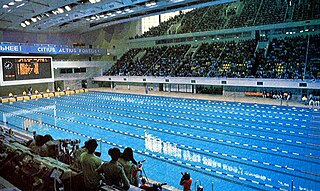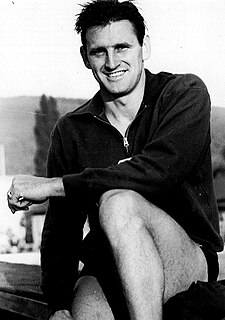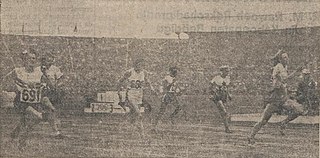
The men's 200 metre breaststroke was one of 6 swimming events on the Swimming at the 1908 Summer Olympics programme. It was the only breaststroke event on the schedule. 1908 was the first appearance of the 200 metre breaststroke, as 1904 had seen the introduction of the stroke to Olympic competition with the 440 yard event. Each nation could enter up to 12 swimmers.

The men's 100 metre freestyle event at the 1980 Summer Olympics was held on 26 and 27 July at the Swimming Pool at the Olimpiysky Sports Complex. There were 39 competitors from 26 nations. Nations had been limited to three swimmers each since the 1924 Games. The event was won by Jörg Woithe of East Germany, the nation's first medal in the men's 100 metre freestyle. Sweden earned its first medals in the event since 1952 with Per Holmertz's silver and Per Johansson's bronze.

The men's 200 metre freestyle event at the 1980 Summer Olympics was held on 21 July at the Swimming Pool at the Olimpiysky Sports Complex. There were 42 competitors from 24 nations, with each nation having up to three swimmers. The event was won by Sergey Koplyakov of the Soviet Union, with his countryman Andrey Krylov finishing second. The medals were the first for the Soviet Union in the men's 200 metre freestyle. Graeme Brewer of Australia won that nation's first medal in the event since 1968 with his bronze.
The women's 200 metre breaststroke event, included in the swimming competition at the 1980 Summer Olympics, took place on July 23, at the Swimming Pool at the Olimpiysky Sports Complex in Moscow, Soviet Union. In this event, swimmers covered four lengths of the 50-metre (160 ft) Olympic-sized pool employing the breaststroke. It was the thirteenth appearance of the event, which first appeared at the 1924 Summer Olympics in Paris. A total of 25 competitors from 18 nations participated in the event.

The women's 200 metre breaststroke event at the 1936 Summer Olympics, took place from 8 to 11 August, at the Olympiapark Schwimmstadion Berlin. It was the fourth appearance of the event, which first appeared at the 1924 Summer Olympics in Paris. A total of 23 competitors from 12 nations participated in the event.
The men's 200 metre breaststroke was a swimming event held as part of the swimming at the 1936 Summer Olympics programme. It was the seventh appearance of the event, which was established in 1908. The competition was held from Thursday to Saturday, 13 to 15 August 1936.

The men's 100 metre freestyle event at the 1948 Olympic Games took place between 30 and 31 July at the Empire Pool. There were 41 competitors from 19 nations. Nations had been limited to three swimmers each since the 1924 Games. The event was won by Wally Ris, returning the United States to the podium in the event after a one-Games absence broke a seven-Games streak. It was the sixth victory for an American in the 100 metre freestyle, most of any nation. Another American, Alan Ford, took silver. Géza Kádas of Hungary earned bronze, the nation's third medal in four Games. Japan's three-Games medal streak in the event ended with no Japanese swimmers competing due to the nation not being invited after World War II.

The men's 100 metre freestyle event at the 1952 Summer Olympics took place between 26 and 27 July at the Helsinki Swimming Stadium. There were 61 competitors from 33 nations. Nations had been limited to three swimmers each since the 1924 Games. The event was won by Clarke Scholes of the United States, the nation's second consecutive and seventh overall victory in the men's 100 metre freestyle. Japan, absent from the 1948 Games after World War II, returned to the podium in the event with Hiroshi Suzuki's silver. Göran Larsson earned Sweden's first medal in the event since 1908 with his bronze.
The men's 200 metre breaststroke event at the 1952 Olympic Games took place between 31 July and 2 August at the Swimming Stadium. This swimming event used the breaststroke. Because an Olympic size swimming pool is 50 metres long, this race consisted of four lengths of the pool.
The women's 400 metre freestyle event at the 1952 Olympic Games took place between 31 July and 2 August at the Swimming Stadium. This swimming event used freestyle swimming, which means that the method of the stroke is not regulated. Nearly all swimmers use the front crawl or a variant of that stroke. Because an Olympic size swimming pool is 50 metres long, this race consisted of sixteen lengths of the pool.
The women's 200 metre breaststroke event, included in the swimming competition at the 1952 Summer Olympics, took place on 26–29 July, at the Helsinki Swimming Stadium. In this event, swimmers covered four lengths of the 50-metre (160 ft) Olympic-sized pool employing the breaststroke. It was the sixth appearance of the event, which first appeared at the 1924 Summer Olympics in Paris. A total of 33 competitors from 19 nations participated in the event.

The men's 100 metre freestyle event at the 1956 Olympic Games took place between 29 and 30 November. There were 34 competitors from 19 nations. Nations had been limited to three swimmers each since the 1924 Games. The event was won by Jon Henricks of Australia, the nation's first medal in the event. Australia would win a second 0.4 seconds later and a third 0.9 seconds after that, sweeping the podium—the first sweep in the men's 100 metre freestyle since the United States did it in 1920 and 1924, and the first sweep of any event by Australian competitors. This year, the Americans finished fourth through sixth. It was the first time since 1924 that Japan had competed but not medaled.
The women's 200 metre breaststroke event, included in the swimming competition at the 1956 Summer Olympics, took place on November 29–30, at the Swimming and Diving Stadium. In this event, swimmers covered four lengths of the 50-metre (160 ft) Olympic-sized pool employing the breaststroke. It was the seventh appearance of the event, which first appeared at the 1924 Summer Olympics in Paris. A total of 14 competitors from 10 nations participated in the event. This was a decrease from the 1952 Summer Olympics, because the breaststroke event was split into the 200m orthodox breaststroke and the 100m butterfly event.
The men's 1500 metre freestyle event at the 1960 Olympic Games took place between September 2 and 3. This swimming event used freestyle swimming, which means that the method of the stroke is not regulated. Nearly all swimmers use the front crawl or a variant of that stroke. Because an Olympic size swimming pool is 50 metres long, this race consisted of 30 lengths of the pool.
The women's 100 metre freestyle event at the 1960 Olympic Games took place between August 26 and 29. This swimming event used freestyle swimming, which means that the method of the stroke is not regulated. Nearly all swimmers use the front crawl or a variant of that stroke. Because an Olympic-size swimming pool is 50 metres long, this race consisted of two lengths of the pool.
The women's 200 metre breaststroke event, included in the swimming competition at the 1960 Summer Olympics, took place on August 26–27, at the Stadio Olimpico del Nuoto. In this event, swimmers covered four lengths of the 50-metre (160 ft) Olympic-sized pool employing the breaststroke. It was the eighth appearance of the event, which first appeared at the 1924 Summer Olympics in Paris. A total of 30 competitors from 19 nations participated in the event. British gold-medalist Anita Lonsbrough became the first swimmer to break the world record in this event, with a time of 2:49.5 in the final.

The women's 200 metre breaststroke event, included in the swimming competition at the 1964 Summer Olympics, took place on 11–12 October, at the Yoyogi National Gymnasium. In this event, swimmers covered four lengths of the 50-metre (160 ft) Olympic-sized pool employing the breaststroke. It was the ninth appearance of the event, which first appeared at the 1924 Summer Olympics in Paris. A total of 27 competitors from 15 nations participated in the event. Soviet Union's Galina Prozumenshchikova and Svetlana Babanina won their country's first ever medals in this event, with a gold and bronze medal respectively. Claudia Kolb's silver medal was the United States' second ever medal in this event, after Agnes Geraghty's silver in the inaugural event in 1924. In the heats, Australian Christine Barnetson was disqualified for an incorrect breaststroke, and Hungarian Márta Egerváry withdrew from the competition.
The women's 200 metre breaststroke event, included in the swimming competition at the 1968 Summer Olympics, took place on October 22–23, at the Alberca Olímpica Francisco Márquez. In this event, swimmers covered four lengths of the 50-metre (160 ft) Olympic-sized pool employing the breaststroke. It was the tenth appearance of the event, which first appeared at the 1924 Summer Olympics in Paris. A total of 31 competitors from 20 nations participated in the event. American Catie Ball was the large favourite to win the event, as she had broken the world record in this event the last three times. However, she was suffering from a virus infection and was forced to withdraw from the heats. Her 16-year-old teammate Sharon Wichman won the event, breaking bronze medalist Galina Prozumenshchikova's Olympic record in the final.
The women's 200 metre breaststroke event, included in the swimming competition at the 1972 Summer Olympics, took place on August 29, at the Olympia Schwimmhalle. In this event, swimmers covered four lengths of the 50-metre (160 ft) Olympic-sized pool employing the breaststroke. It was the eleventh appearance of the event, which first appeared at the 1924 Summer Olympics in Paris. A total of 40 competitors from 23 nations participated in the event, another 2 entries from 2 other countries did not compete.

The women's 100 metres sprint event at the 1948 Olympic Games took place July 31 and August 2. The final was won by Dutchwoman Fanny Blankers-Koen.










